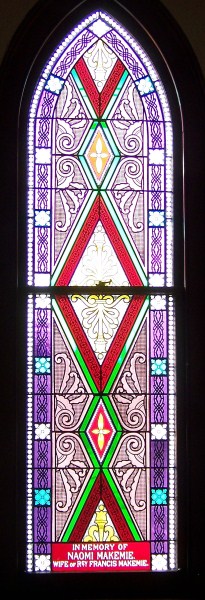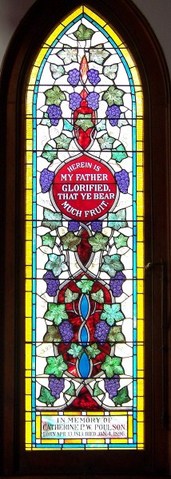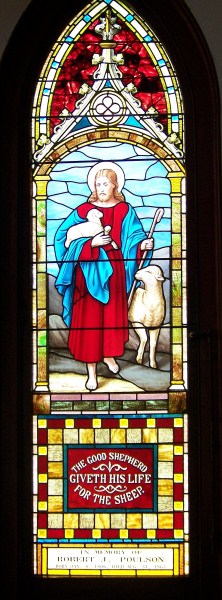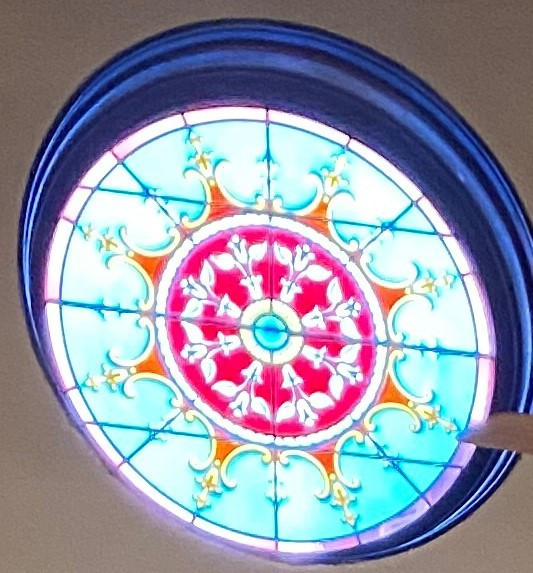Stained Glass Windows

Naomi Makemie Presbyterian Church
Onancock, Virginia
Onancock, Virginia
About Us ~~~
The church building of the Naomi Makemie Presbyterian Church, was dedicated on November 29, 1896, almost 200 years after the Accomack County Court granted to Francis Makemie the right to conduct religious services in the Onancock home given to him and his bride, Naomi Anderson, by her father. Describing the dedication of the new church, the local newspaper commented on the comfort and high-quality workmanship of the new structure, with particular emphasis on the stained glass windows. The reporter wrote:
There are in the church twenty windows of superior stained glass, eight of them being memorial windows. The two windows on the right and left of the pulpit are in memory of the Rev. Francis Makemie. The other windows are in memory of Mrs. S.T. Young, John T. Powell, Robert H. Miles, Robert J. Poulson, and his wife, the late Catherine P.W. Poulson.
Today, over 110 years later, the windows are still here — almost the way they were in the beginning. As a result of construction, storm damage and vandalism, several of the windows are not in their original position. The Makemie memorial windows at the back of the church were at one time at the front, moved when the new addition was added in 1954. The new addition resulted in the removal of three windows which were put into storage until recently. The bottom of the window on the front right side was replaced by one of the stored windows after vandals damaged the original. The top sections of two of the stored windows are now displayed in the foyer of the new tower. Seventeen of the original windows still grace the Sanctuary and adjoining room.
The windows were made in Germany and purchased through a Baltimore dealer named Gerhardt. The importer has long since gone out of business, and no records remain of the selection, purchase or transport of the windows. They were probably all ordered at the same time, shipped down the Bay by boat and unloaded at the dock in Onancock Harbor – most likely at Hopkins & Brothers.
It was the Victorian Era when appreciation of fine stained glass was at its zenith, and throughout the Eastern Shore of both Maryland and Virginia, church buildings were being erected displaying this European art. The memorial windows of Naomi Makemie are among the finest examples in the area of this period.
Over the years various necessary repairs have been made as a result of age, storm damage and vandalism. In 2005 it was determined that the windows had to have major repairs or face the possibility of losing them within a few years. Each window was removed and shipped to the Shenandoah Stained Glass Company for a complete restoration. They now appear as bright and beautiful as they first did in 1896.
The designs of the windows are intended to communicate our Christian beliefs in color, shapes, designs and detailed imagery of popular bible stories. The Naomi Makemie windows are done in the high style popular in Victorian Europe of the late 1800’s.
Today, over 110 years later, the windows are still here — almost the way they were in the beginning. As a result of construction, storm damage and vandalism, several of the windows are not in their original position. The Makemie memorial windows at the back of the church were at one time at the front, moved when the new addition was added in 1954. The new addition resulted in the removal of three windows which were put into storage until recently. The bottom of the window on the front right side was replaced by one of the stored windows after vandals damaged the original. The top sections of two of the stored windows are now displayed in the foyer of the new tower. Seventeen of the original windows still grace the Sanctuary and adjoining room.
The windows were made in Germany and purchased through a Baltimore dealer named Gerhardt. The importer has long since gone out of business, and no records remain of the selection, purchase or transport of the windows. They were probably all ordered at the same time, shipped down the Bay by boat and unloaded at the dock in Onancock Harbor – most likely at Hopkins & Brothers.
It was the Victorian Era when appreciation of fine stained glass was at its zenith, and throughout the Eastern Shore of both Maryland and Virginia, church buildings were being erected displaying this European art. The memorial windows of Naomi Makemie are among the finest examples in the area of this period.
Over the years various necessary repairs have been made as a result of age, storm damage and vandalism. In 2005 it was determined that the windows had to have major repairs or face the possibility of losing them within a few years. Each window was removed and shipped to the Shenandoah Stained Glass Company for a complete restoration. They now appear as bright and beautiful as they first did in 1896.
The designs of the windows are intended to communicate our Christian beliefs in color, shapes, designs and detailed imagery of popular bible stories. The Naomi Makemie windows are done in the high style popular in Victorian Europe of the late 1800’s.

The large triple-paneled window was given as a gift by the Sabbath School upon the dedication of the new church building in 1896. The overall theme is one of growth in faith and the fellowship of the people with God. The dominant theme of red symbolizes Pentecost and the Holy Spirit. Its focal point is a striking round inset of a pure white dove on a brilliant royal blue background representing the ascension of Jesus Christ.
Deep borders of green and red with flowers represent eternal life. The pink with stylized oak leaves is also a symbol of life. Diamond shapes with the semi circles (broken by frame) are a representation of the body of the congregation of the church. The overall theme of the window stresses life and faith - strong like an oak.
Deep borders of green and red with flowers represent eternal life. The pink with stylized oak leaves is also a symbol of life. Diamond shapes with the semi circles (broken by frame) are a representation of the body of the congregation of the church. The overall theme of the window stresses life and faith - strong like an oak.
The Holy Spirit Window

Flanking the Holy Spirit Window are two identical windows honoring the Rev. Francis Makemie and his wife, Naomi Anderson Makemie. Originally at the other end of the Sanctuary, one on either side of the pulpit they were re-located during the construction of the new Sunday School addition in 1954.
The windows are full of Christian symbolism of the period as a tribute to the work and life of Francis Makemie. The color pink represents the joy of life, white represents the purity in our beliefs in Jesus Christ, the greens and reds represent eternal life, and gold represents the royalty sovereignty of God.
The windows are full of Christian symbolism of the period as a tribute to the work and life of Francis Makemie. The color pink represents the joy of life, white represents the purity in our beliefs in Jesus Christ, the greens and reds represent eternal life, and gold represents the royalty sovereignty of God.
The Makemie Windows
The Five Memorial Windows
The five memorial windows along the west wall of the Sanctuary are dedicated to members of the community and members of the original congregation. They are (in order, from the Market Street end to the Choir end of the west wall) memorials to Mrs. Sally T. Young, Catherine P.W. Poulson, Robert J. Poulson, Robert I. Miles, and John T. Powell.
Although these windows came from the same importer, and all were designed and crafted in Germany, they are each different in style and choice of colors. They do not clash with each other however, but blend into a symbolic panorama rich in memories of the families of the first congregation and as reminders of our Christian tradition and Biblical heritage.
Although these windows came from the same importer, and all were designed and crafted in Germany, they are each different in style and choice of colors. They do not clash with each other however, but blend into a symbolic panorama rich in memories of the families of the first congregation and as reminders of our Christian tradition and Biblical heritage.
This is a very vivid window, surrounded by a green cable with intersection of a white square with a stylized flower and a cross. The main portion is bordered with a red band and contains symbols of stylized wheat that symbolizes the communion table. The blue circles represent eternity and re-enforces our belief in the promise made by Jesus at the last supper.
Sally T. Young was the wife of Dr. E.J. Young and the daughter of William and Elizabeth C. Parramore. She is buried at Seven Gables in Accomac. She is believed to be the mother of an active member in the new Naomi Makemie Presbyterian Church
Sally T. Young was the wife of Dr. E.J. Young and the daughter of William and Elizabeth C. Parramore. She is buried at Seven Gables in Accomac. She is believed to be the mother of an active member in the new Naomi Makemie Presbyterian Church

The Sally T. Young Window
(Born Sept 1829 -- Died June 1861)
(Born Sept 1829 -- Died June 1861)
A brief summary of the more common colors and shapes.
The Catherine P.W. Poulson Window
(Born April 13 1813 -- Died Jan 4 1896)
(Born April 13 1813 -- Died Jan 4 1896)
An overall design of twining purple grapes and green leaves on gray stems overlay a mottled ivory background. The glass is heavy and textured, creating a richness that is appropriate to the overall symbolism of both the Communion sacrament and the fruitfulness of the person who labors for the Lord.
Catherine Poulson was the daughter of John and Tabitha Custis. She is buried in the Poulson Family graveyard near Onancock. Neither Mrs. Poulson nor her husband Robert was listed on the rosters of the church. Indeed, the Poulson family was instrumental in the founding of Cokesbury Methodist Church further up Market Street towards the harbor. It is likely that the windows dedicated to the two Poulson were given by a child or a member close to the family.
Catherine Poulson was the daughter of John and Tabitha Custis. She is buried in the Poulson Family graveyard near Onancock. Neither Mrs. Poulson nor her husband Robert was listed on the rosters of the church. Indeed, the Poulson family was instrumental in the founding of Cokesbury Methodist Church further up Market Street towards the harbor. It is likely that the windows dedicated to the two Poulson were given by a child or a member close to the family.

The Robert J. Poulson Window
(Born January 8, 1806 -- Died August 31, 1863)
(Born January 8, 1806 -- Died August 31, 1863)

Christ as the Good Shepherd...it is unique in the group in that the image fills almost the entire window. Christ is depicted carrying a lamb and a crook, with another sheep at His side. In typically Gothic style, this picture is enclosed in an intricately carved architectural arch, through which twine trefoil leaves symbolizing the Holy Trinity. Underneath, lettered in silver-white on a carmine background bordered in teal, is the inscription "The Good Shepherd Giveth his life for the sheep.”
Robert J. Poulson is buried with his wife in the Poulson Family graveyard.
Robert J. Poulson is buried with his wife in the Poulson Family graveyard.
The Robert H. Miles Window
(Born Nov 23 1839 -- Died March 28 1885)
(Born Nov 23 1839 -- Died March 28 1885)
This is one of the more beautiful windows. Stained glass windows are supposed to tell a story. This window calls to mind two or three stories of the scriptures. At the bottom of the window, the motif that stands out is the chalice and a loaf of bread on a plate; decorated in the red background are beautifully etched vines and grapes in reference to communion. Bordered by a kind of artistic rope that goes all the way up through the window, the purple color represents royalty. Green is entwined with that rope all through the window as a sign of life. As one looks higher up the window the second major element that leaps out is a picture of the risen Christ emerging from the tomb. One can see in His side a wound and he is bearing a banner – a purple banner of victory. On one side of the tomb is an angel who may be the angel who rolled away the stone that blocked the tomb. Also, very visible in the picture are the bodies of three Roman centurions – two of them are crouching and the other one is turning away. The blinding light of the resurrection turns them away – they can’t bear to look at it so they are turning away. Then one looks to the top of this window and there is a beautiful arrow shaped segment which points upwards towards the heavens. The white symbolizes victory and purity and resurrection. And intertwining the arms of the cross is a green wreath which once more is a symbol of new life through Christ as the cross is the path to life.
Mr. Miles was the leading layman of the early Presbyterian congregation in Onancock. He was elected and ordained a Ruling Elder in September 1883. In 1884, because of failing health, he moved to Florida, where he died the following spring.
Mr. Miles was the leading layman of the early Presbyterian congregation in Onancock. He was elected and ordained a Ruling Elder in September 1883. In 1884, because of failing health, he moved to Florida, where he died the following spring.

The John T. Powell Window
(Born April 14 1827 -- Died Aug 20 1890)
(Born April 14 1827 -- Died Aug 20 1890)

This window is dominated by the sheaf of wheat in its center, a symbol of communion – the Lord’s Supper. Extending out from the sheaf and up around the window is a vine of grape leaves which likewise is related to the Lord’s Supper. And at the top of the window is a beautiful crown set within a white background. This brightly colored crown represents the lordship of Jesus Christ. This window is full of color and texture. Inherent in these themes is faith in our own redemption through the sacrifice, triumph and glory of the Lord. The violet ribbon banding the sheaf reminds us of our need for penitence and reconciliation with God to attain our promised inheritance.
John T. Powell is buried in the Onancock Cemetery with his wife, Roberta Ker Powell
John T. Powell is buried in the Onancock Cemetery with his wife, Roberta Ker Powell
Gold and maroon represent the royalty of God
Red symbolizes Pentecost and the Holy Spirit.
An eye represents the eye of God – look for the eye in the Rose at the top of the front of the church.
The use of white symbolizes innocence, resurrection and eternity
Pink generally refers to joy.
Wheat becomes a symbol of communion – the Lord’s Supper
Grapes and grape leaves are related to the Lord’s Supper.
Green represents eternal and new life through Jesus Christ.
Purple represents spiritual growth through Jesus Christ
Red symbolizes Pentecost and the Holy Spirit.
An eye represents the eye of God – look for the eye in the Rose at the top of the front of the church.
The use of white symbolizes innocence, resurrection and eternity
Pink generally refers to joy.
Wheat becomes a symbol of communion – the Lord’s Supper
Grapes and grape leaves are related to the Lord’s Supper.
Green represents eternal and new life through Jesus Christ.
Purple represents spiritual growth through Jesus Christ
This information is taken from a brief history of the church by Ms. Brooke Tompkin (early 1990s) and an oral report by Dr. Gene Soud recorded in 2006

Our Mission Statement
“Do what is fair and just to your neighbor, be compassionate and loyal in your love, and don’t take yourself too seriously—take God seriously.” Micah 6:8
Compassionate, Fair and Loyal